The LG B6, by virtue of being the most affordable model within the South Korean TV maker’s 2016 OLED lineup, has attracted the greatest attention among video enthusiasts, especially after the company pretty much intimated there’s little difference in picture quality compared with step-up E6 and G6 ranges. The LG OLEDB6 features a UHD (ultra high-definition) screen resolution of 3840×2160, WRGB OLED technology, a flat-panel design, HDR (high dynamic range) support for both HDR10 and Dolby Vision formats, Ultra HD Premium certification, as well as WebOS 3.0 Smart TV platform, but no 3D capability.

We’ve been spending time with a 55-inch LG OLED55B6V (it’s also available as the 65in OLED65B6V) in our test room for the past few weeks. A public firmware update (version 04.30.50) which landed on the 28th of October in the UK resolved so many issues that we felt compelled to revamp the format of this review to highlight the improvements.
1) No More 4K Blu-ray Frame Skipping
When we first received our OLED55B6V-ZA review sample and watched some Ultra HD Blu-rays from a Samsung UBD-K8500 player, we noticed unmistakable frame skipping (some may describe this as “stutter”) every 13 seconds or so, similar to what we had witnessed on the LG 55UH770V LED LCD television which uses the same Realtek RTD2999 SoC (system-on-chip).
Firmware 04.30.50 eradicated the frame skipping, so slow panning shots in 24fps HDR material would proceed smoothly (well, as smooth as 24p allowed) without interruption from stuttering. We’re not entirely sure whether this is related to the fix, but the LG 55B6 would fail 3:2 and 2:2 film-mode deinterlacing tests even with [Real Cinema] engaged, but pass them once [Real Cinema] was switched off and on again. In any case, we’d gladly take stutter-free 4K Blu-ray playback over flawless deinterlacing, given that many owners are unlikely to watch interlaced standard-definition content, and deinterlacing artefacts aren’t going to be very noticeable at high-def resolution.
2) More Accurate PQ EOTF Tracking
Just like the LG 65E6 we tested several months ago, the OLED55B6 was initially displaying HDR10 images from 4K Blu-ray movies in a brighter manner than the luminance levels specified by SMPTE’s ST.2084 standard, presumably to create the impression of a brighter picture in compensation for OLED’s lower peak brightness (relative to top-tier LED LCD TVs). To produce accurate tracking of the PQ (perceptual quantisation) EOTF (electro-optical transfer function), we had to decrease [OLED Light] to “63“, which of course also dropped peak brightness to 421 nits.
Imagine our joy when we discovered that firmware version 04.30.50 yielded PQ EOTF tracking that’s more faithful to the current HDR10 standard on our LG B6 review unit. Ok, it remained slightly too bright, but even after making some adjustments to obtain accurate PQ tracking, peak brightness still exceeded 500 nits comfortably, resulting in less clipping of highlight detail.
Click on the options below to compare PQ tracking:
Old firmware [OLED Light] “100“ | Old firmware [OLED Light] “63“
Firmware 04.03.50 [OLED Light] “100“ | Calibrated after firmware
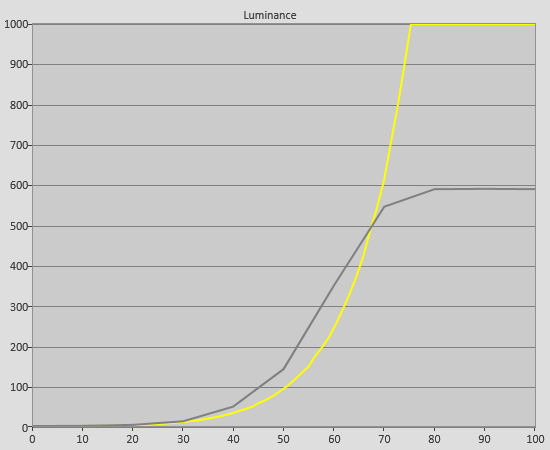
Here’s a side-by-side comparison against a 1000-nit Ultra HD Premium LED LCD TV of the sun in Chapter 18 of Kingsman: The Secret Service, a 4K Blu-ray disc that has been mastered to 1000 nits. As always, please refrain from drawing conclusions directly from the photos included in this article, since we had to intentionally lower our camera’s exposure to fully capture highlight detail from UHD BD HDR.
 |
| Left: UHD Premium LED TV; Right: LG OLED55B6V |
However, although the new firmware helped preserve white specular highlights better, bright colours still appeared more muted and showed a coarser degree of gradation than those presented by higher-end LED LCDs, underlining the importance of sheer peak brightness to colour volume:
 |
| The last flickers of a dying flame in Mad Max: Fury Road (timecode: 00:30:06) |
3) Finer TruMotion Controls
LG has also tweaked the 55B6’s [TruMotion] controls in the latest firmware update. No, maximum motion resolution hasn’t been boosted (it remained at 650 lines according to the horizontally scrolling lines in Chapter 31 of the FPD Benchmark Software test disc); black frame insertion (BFI) hasn’t been introduced (as much as it’s craved by ex-plasma and CRT TV owners); and we’d still avoid [TruMotion] “Clear” and “Smooth” because of overt soap opera effect (SOE) and interpolation artefacts.
From our testing, what LG’s engineers did was to halve the intensity of the [De-Judder] control in the [TruMotion] “User” submenu, essentially providing finer, half-step adjustments on the OLED55B6V. This can prove useful for owners who are sensitive to the judder inherent in 24p film and would like to smooth it out without incurring too much SOE or interpolation artefacts.
Vs OLED55E6V
A question that will play on the minds of prospective LG B6 buyers is whether to fork out extra money for the more expensive E6 model: is there any actual difference in picture quality, putting aside the lack of 3D, integrated soundbar and “OLED-on-Glass” design?
Fundamentally, the LG OLED55B6 and OLED55E6 use different chipsets: the former carries one from Realtek (RTD2999); whereas the latter features LG’s own in-house solution, as you can see from the sets’ respective service menus:
 |
 |
| LG B6 service menu | LG E6 service menu |
Subjectively, the OLED55B6V’s calibration controls behaved more like a late 2015 EF950V/ EG960V, though it’s still possible to obtain a very accurate greyscale. That said, the B6V’s less refined [Brightness] slider meant that it’s easy to float/ crush blacks unless extreme care was taken during calibration.
Greyscale
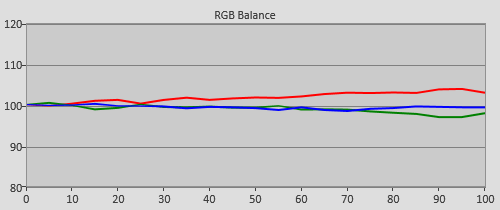 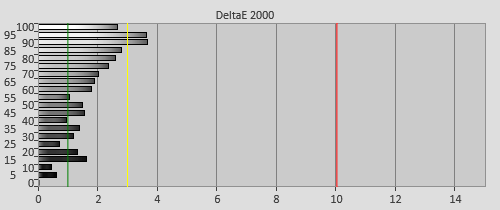 |
| Pre-calibration [ISF Expert] RGB tracking and delta errors (dEs) |
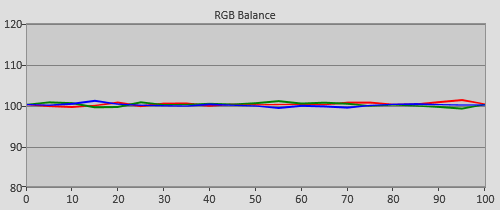 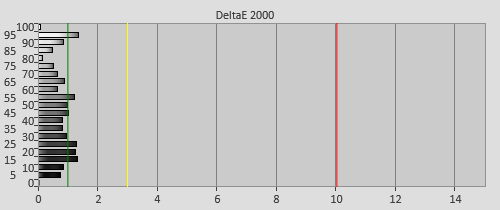 |
| RGB tracking and dEs after 2p & 20p [White Balance] calibration in [ISF Expert] mode |
Gamma
![Pre-calibrated Gamma tracking in [ISF Expert] mode](/news/wp-content/uploads/2018/04/uhdtv_LG-OLED55B6V_pre-gamma.png) |
![Post-calibrated Gamma tracking in [ISF Expert] mode](/news/wp-content/uploads/2018/04/uhdtv_LG-OLED55B6V_post-gamma.png) |
| Pre-calibration gamma tracking (2.39) | Post-calibration gamma tracking (2.38) |
Colour
![Post-calibration colour saturation tracking in [ISF Expert] mode](/news/wp-content/uploads/2018/04/uhdtv_LG-OLED55B6V_post-strack.jpg) |
| Post-cal colour saturation tracking against Rec.709 standard |
![Post-calibration colour errors in [ISF Expert] mode](/news/wp-content/uploads/2018/04/uhdtv_LG-OLED55B6V_post-strack-de.png) |
| Post-calibration colour errors (<3 not appreciable to the eye) |
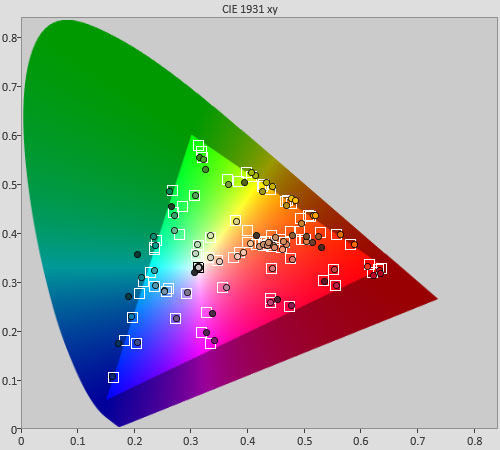 |
| Post-calibration Colour Checker SG test |
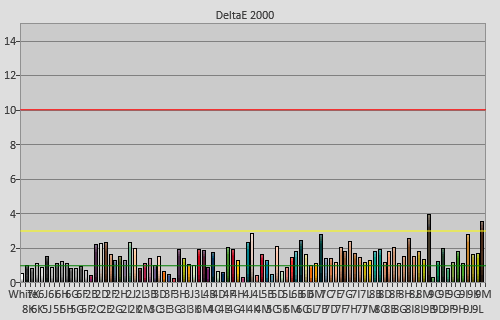 |
| Post-calibration Colour Checker SG errors (<3 not appreciable to the eye) |
Our LG OLED55B6 review sample exhibited very good near-black uniformity with no sign of vignetting or brightening along the sides even on a 1% above-black full-field raster, but we’ve observed some B6 units in the wild with brightened sides possibly due to overcompensation by the manufacturer to tackle vignetting.
Benchmark Test Results
| Dead pixels | None |
| Screen uniformity | No vignetting or brightening; near-black thin streaks |
| Overscanning on HDMI | 0% with [Just Scan] enabled |
| Blacker than black | Passed |
| Calibrated black level (black screen) | 0 cd/m2 |
| Calibrated black level (4×4 ANSI) | 0 cd/m2 |
| Black level retention | Blacks occasionally float |
| Primary chromaticity | Good |
| Scaling | Very good for HD |
| Video mode deinterlacing | Effective jaggies reduction |
| Film mode deinterlacing | Passed 3:2/480i+1080i & 2:2/576i cadence tests |
| Viewing angle (cone) | 166° |
| Motion resolution | 650 with [TruMotion] engaged; 300 otherwise |
| Digital noise reduction | Optional; effective when engaged |
| Sharpness | Very mild undefeatable edge enhancement |
| Luma/Chroma bandwidth (2D Blu-ray) | Full Luma; Chroma horizontally blurred |
| 1080p/24 capability | No judder |
| 2160p/24 capability | No judder |
| Measured panel refresh rate | 120Hz |
| Measured peak brightness | 633 cd/m2 10% window; 122 cd/m2 full-field |
| Measured DCI-P3 coverage | 98% |
| Leo Bodnar input lag tester | 44ms in [Game] mode; 55ms-71ms in HDR mode |
| Full 4:4:4 reproduction (PC) | Yes for both 1920×1080 and 3840×2160@60Hz |
Power Consumption
| Default [Eco] mode | 138 watts |
| Calibrated [ISF Expert] mode | 95 watts |
| [HDR Standard] mode | 188 watts |
| Standby | <1 watt |
Miscellaneous Data
| Macro photo of subpixel configuration verifying LG Display’s WRGB OLED layout |
| Horizontal viewing angle of LG OLED55B6V |
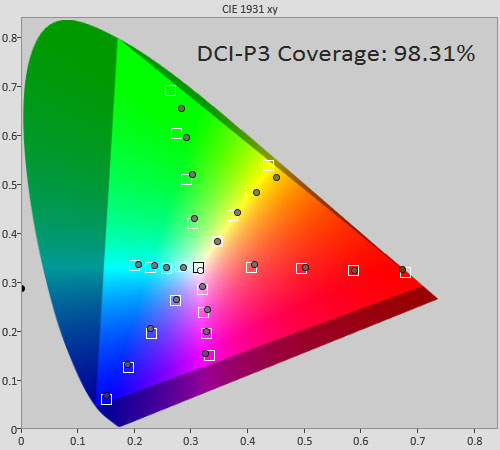 |
| Percentage of DCI-P3 colour gamut coverage according to UHDA methodology |
![Input lag in [Game] mode](/news/wp-content/uploads/2018/04/uhdtv_LG-OLED55B6V_lag.jpg) |
![Input lag in [HDR Standard] mode](/news/wp-content/uploads/2018/04/uhdtv_LG-OLED55B6V_hdr-lag.jpg) |
| Input lag in [Game] mode | Input lag in [HDR Standard] mode |
Unlike a growing number of TV brands who have started offering gamer-friendly HDR mode, LG only provides the existing three HDR presets on their 2016 televisions once HDR metadata was detected (including for HDR games such as Gears of War 4 and Forza Horizon 3). With [TruMotion] disabled, the LG 55B6 returned a lag figure of between 55ms and 71ms in [HDR Standard] mode: it would start off at 71ms, drop slowly to 55ms before jumping back up to 71ms, after which the cycle would repeat.
Verdict
Being a self-emissive display, the LG OLED55B6V already delivers some of the best SDR (standard dynamic range) images on the market thanks to true blacks, vibrant colours and wide viewing angles. But the latest firmware upgrade has truly enhanced the set’s HDR performance: PQ EOTF tracking was more accurate; shadow and highlight details were better preserved (once the correct settings were applied); and 24fps frame skipping from 4K Blu-ray playback had been fixed.
While some issues remain, these improvements now make LG’s 2016 OLEDs a very credible alternative to flagship FALD (full-array local dimming) LED LCDs for HDR viewing, especially when you take into account OLED’s ultra-precise pixel-level illumination which is completely devoid of haloing/ blooming artefacts, and the B6’s Dolby Vision compatibility.
Above all, this firmware release showed that LG is not resting on its laurels despite owning the best commercially viable large-sized display technology today – the company’s engineers are constantly working on improving picture quality based on constructive feedback from technical reviews and shootout events. Following a recent price drop to below £2000, the LG 55B6V represents incredible value for money given its superb image quality.



Floaring black and near black issues still apparent.
And people actually believed lg was going to introduce bfi hahaha.
These lg oled tvs will be plagued with issues until some other company makes oled or introduces their own processing.
Hi.so what do recommen for oled light in HDR then.100-90-85.on the b6
We need a HDR game mode on these 2016 models inc B6 and E6, please request from LG and fight for our case :)
Steve
HDR mode will not come on 2016 models only on 2017 lg says.
Hi Vincent,
Do you know if these 2016 OLED TV’s, Particularly the more affordable B6 will get an update for hybrid log gamma HDR? It looks like it will be the HDR standard for broadcast TV and with Iplayer going 4K we might see it soon.
I would totally pick this over the E6 if the input lag would be the same but still, the price difference is too much for a little bit better input lag, maybe I couldn’t even feel the difference between 34vs44 ms, both are good enough for 3rd person story games.
Comment on the review: I think this is the most helpful review out there. I really like this pros and cons separation in the recent reviews. But in the end I’m still confused which one to pick (because of the above mentioned input lag) but it’s not the reviews fault, I have to make the decision :)
Better PQ EOTF sure but OLEDs still have problem with low microcontrast.
whats limits it is probably the WRGB filter.
High peakbrightness form 10% windows doesnt tell the true story of what brightnesslevels you will get on the scenes.
The funny thing is that even at 330cd/m2 a KRP-500A with its 197cd/m2 is still brighter with higher brightness on small objects.
OLEDs still has a long way to go until they reach the amazing microcontrast that makes the KUROs what they are.
i think we need an true RGB OLED soon ;)
so Stuart
not impressed by the loleds yet?
it takes more right haha
Example of the low microcontrast on the OLEDs compared to a KRP-500A
http://privat.bahnhof.se/wb192876/Texture1.jpg
I’m glad that LG is willing to make improvements with their firmware, but I’m still saving my money for 2017 – or even longer if needed. I went through two B6 panels and couldn’t overlook their flaws. The near-black uniformity, black crush, and shoddy upscaling might not be a big deal to some people, but coming from a calibrated VT60 plasma, I feel LG still has their work cut out for them in regards to what truly makes up a reference picture.
B6 is better then the vt60 it is coming from vt60 my self.yea it has some problem with poor source but with HDR 4K or blu ray disc the vt60 dont stand a chance.
What do you use for your settings? Or at minimum what do you set your tru-motion at?
Sun Scene from Kingsman on a KRP-500M but with the Blu Ray version
http://privat.bahnhof.se/wb192876/KRP-500M_Kingsman.jpg
if you was able to capture all highlight details on those photos above im sorry to say that the Blu Ray version on this tv gives exactly the same highlight details.
obviously less torch mode here.
Cameras used today in movies have different levels of dynamic range or how many stops they can capture.
its not allways a limit with the SD standard we see when we see clipped highlights
just one note :)
dont blame lost hightlights on the SD standard when it can be the cameras that sets the limits.
look closer to what cameras that was used and how well they captures the dynamic range instead
it seems that the cameras used in Kingsman TSS can capture a high level of dynamic range without clipping anything
details that still shows up on SD content.
SDR (Standard Dynamic Range) content that is.
@Stuart: I’ve just checked… why are you registering under different false names to criticise LG OLEDs? How has LG wronged you?
/news/wp-content/uploads/2018/04/twitter_comment.gif
@Steve: Will feed this back to LG, thanks for your patience.
@Tony: Nothing’s been confirmed at this stage.
@Patrik: But your Blu-ray sun will not come close to 1000 nits, so it’ll never look as realistic. It’s not only highlight detail preservation, but also the luminance output reached.
As much as you love your KRP-500M, there are a few problems I see:
1) You’ve adjusted it via service menu, so it’s not representative of all KRP-500M on the market;
2) No one else can buy a KRP-500M new on the market currently; and
3) Why would anyone? Given that your KRP-500M can’t play 4K Blu-ray natively. Can your TV fully resolve this sun scene in Mad Max: Fury Road (mastered to 4000 nits)?
/news/wp-content/uploads/2018/04/article_4k-bd_madmax-2-large.jpg
Warmest regards
Vincent
If your basis for judging PQ is solely on the ability to produce zero black, then yes, it has the VT/ZT and later Kuros beat. But in terms of shadow detail and the ability to handle near-black issues without pixelation/noise, I still feel a plasma is superior. Even the Sony Z handles a lot of these issues better than the LGs from reports I have read.
99% of my viewing habits are still SDR content. And there were many older BDs and streaming via Netflix and Amazon scenes that just made me cringe on my B6.
I am hoping LG makes improvements in 2017 to help reduce these issues. Panasonic shows promise, but their lack of presence in the US market gives me little hope that they’ll be able to compete with LG – especially with their current price slashing.
How can the frame skipping be fixed if the input lag cycles? If the input lag goes from high to low in an instant a frame must be lost or displayed very briefly. I have tried to illustrate this here:
https://www.avforums.com/threads/no-hdr-game-mode-for-2016-oled-models.2062022/page-4#post-24350611
How can a 4K TV be released with HDR colour mapping problems and frame skipping issues. Where is the testing and quality control of the product. Not everybody has access to firmware updates. LG is not helping their OLED cause.
LG needs to fix their SDE. These huge holes between the pixels look horrible.
@Mark Wessels: SDE is not a problem at all on 4K OLEDs – in fact they all looking sharper than any plasma.
Warmest regards
Vincent
On the chipset front does the C6 have the E6 or B6 one?
The recent input lag testing suggests the C6 is closer to the E6 as they mirror each other in testing as opposed to the B6 which is different.
Main reason for asking is that I was looking at the 55″ E6 but Currys are selling the 65″ C6 for the same price now.
Hi Vincent,
thank you for the update, I have a few questions left and maybe you can help. With a PS4 Pro which settings should an LG 2016 owner use for HDR gaming (YUV420 or RGB?). There are discussion that the automatic option of the PS4 Pro leads to problems since the system automatically uses 8BIT-HDR, while YUV 420 uses 10BIT-HDR.
What’s the deal with this firmware update?
I’m in the North American market, have a 65B6, and still am not seeing 04.30.50 as being available.
To update the firmware you might have to switch “service country location” to UK
Undefeatable edge enhancement? What? How? Why? Did we travel back to 2010 or something? Sigh…
Also in the initial E6 review it was reported that the set followed P3 colors instead of Rec2020 causing hue shifts on UHD BDs, did they ever fix this in firmware?
@Vincent
Which truemotin settingd have you used?
*truemotion settings
Great review. So now what’s the best Oled light and contrast setting for HDR? Both are on 100 I use HDR standard user
The B6 still has not received the HDR game mode update. It also has issues with stuttering on DTV sources (Tested with Freeview here). Some members of avsforum and avforums have confirmed this. It happens more with Trumotion enabled but even happens with it disabled (and Real Cinema off too). Using hard disk recording to playback the same scene that hitches shows it is not repeatable and thus must be a live issue. I do not see any of this on 23.976 FPS material however. I am wishing I paid for the E6 now.
What was contrast set to in the new firmware to get the results above (with oled 100)?
No matter what reviews and comments I read on the B6V, no one mentions this set’s performance on the reception of Freeview and FreeSat transmissions. It’s all about Blue-ray, gaming and other periphery connected equipment and their relationship with this tv. My main viewing is live and HHD recorded programmes. I’m relatively easy to please, but, on a recent visit to PC World, I was greatly impressed with the ‘in-store’ performance of this tv, but, I did appreciate that the programme source was from a connected blue-ray player not terrestrial or satellite tv. I would be appreciative of any feedback on this issue. Bill.
Hi Vincent
I recently bought anew lg B6 oled and love the picture….except for the undefeatable edge enhancement.
Please please please if you are able to contact LG and see if they are planning to issue a firmware update I would be enormously grateful.
I’m really upset to find that a videophile set such as this cannot provide full picture controls to discerning customers.
I really don’t want to send the set back but if there is no chance of a cure for the forced sharpening then I will be left no choice.
Many thanks
Chris Williams